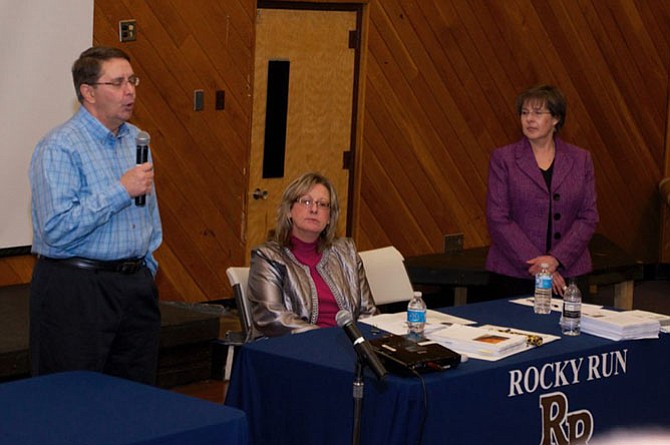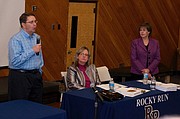Sully Supervisor Michael Frey welcomes attendees to the annual Sully Budget Town hall meeting, to his right are Susan Datta, Director Fairfax County Department of Management and and School Board member Kathy Smith. Photo Contributed
Sully District Supervisor Michael Frey oversaw his last Town Hall Budget meeting on March 25. The topic of the meeting were the Fiscal Year 2016 budget proposals for both Fairfax County and Fairfax County Public Schools.
Both Fairfax County Chief Financial Officer Susan Datta and Fairfax County Public Schools Chief Operating Officer Susan Quinn expressed concern over their respective budgets, as revenue sources for the county have under-produced relative to previous years. Quinn said the only reason FCPS was able to start with a mandated balanced budget was because they took $20.7 million from reserves.
In spite of the less than encouraging financial news, Frey addressed the attendees of the Town Hall Meeting with a hearfelt thanks for the many positive experiences he had in his 24 years of public service.
"For me it has been 24 years and this will be my last budget meeting," Frey said. "After 24 years, I will not seek re-election. It is time for me to move onto something else and for new leadership to come on. So thank you for the honor and privilege you have given me to represent you."
Frey also prefaced the budget presentations with a weary view of Washington.
"Being as close as we are to Washington D.C., that is really what drives our economy," he said. "We continue to see our economy staying and staying and of course at the same time we are seeing continued growth in needs demands and services of the school system. Language issues and special needs student populations are growing and they do a wonderful job in the schools. But it doesn't come cheap. It costs money. We continue to face challenges."
Fairfax County’s Proposed Budget, totaling $7.13 billion and presented by Datta, reflects the slow economic growth that Northern Virginia is seeing overall. The local economy is underperforming compared the national economy, with only a 0.4 percent job growth in 2014.
“We are seeing effects of sequestration and the federal government’s inability to pass a budget,” Datta said. “There has been lackluster job growth. In 2014, we created about 5,000 jobs, which is opposed to more than double this in 2013. We are not going to see a change in revenues until this changes.”
She said that 64 percent of all revenue comes from real estate taxes, while residential real estate values are growing slowly and commercial real estate values are falling.
“We are really in a stagnant situation,” Datta said. “Not only are we not getting better, but we are getting a little worse. We are growing at a rate less than what we were last year. Residential values are growing at about half the rate of last year’s and commercial values are actually declining. We are going to really have to make tough decisions as we go forward."
The county has about $98 million of additional revenue to address the county’s needs in 2016. Two-thirds of it will go to the school system for school operations and debt services. The remainder will go to county programs.
Fairfax County is one of only 37 counties in the United States that has a triple A Bond rating, and the county will strive to preserve this. However, the rating agency has expressed concern over the state of Fairfax County’s accounts.“We have a bank account of about five percent,” Datta said. “The rating agency believes this is not sufficient. We really need to be cognizant that we have to put some money on those reserves.”
The total reductions in the 2016 budget amount to $26.9 million and affects mostly county agencies.
“This is not the first year we have made cuts in the county budget,” Datta said. “We have done this since 2008. Our revenue growth is about 2.5 percent with the current real estate tax rate, and that is really small.”
Budget cuts won’t affect defibrillators throughout the county.
Trish Nyberg asked where the defibrillators fit into the county budget.
"We just had someone saved yesterday, at Lee District Park," Datta said. "So every county facility has one, every school has one. It is funded out of our self-insurance fund. We have heard such wonderful things. It worked, and we are thankful."
Due to concerns for the 2017 budget and beyond, the county is in the process of establishing Lines of Business reviews (LOBs) for the Board of Supervisors to determine what programs are nice to have but not essential. LOBs should be ready for the board to review by the beginning of the next calendar year.
There is a $7.5 million difference in the FCPS proposed budget and the county’s budget, said Quinn, who echoed Datta’s concerns about the county’s financial situation.
“We have proposed a very pragmatic budget for 2016,” Quinn said. “Revenues aren’t really keeping pace with the requirements and expenditure increases. There has been a cumulative budget reduction since 2008 of nearly $435 million and more than 2,175 positions have been eliminated.”
She said FCPS focused on keeping the classrooms intact, so most reductions were aimed at eliminating central support.
Trish Troscianecki of Virginia Run asked how ESOL success was tracked, given that it is a considerable part of the FCPS classroom budget.
"ESOL represents 17 percent of the budget, so $117 million is for ESOL," Troscianecki said. "But no reports on proficiency levels over time. What is our return on the program?"
Quinn responded that specific statistic may not be readily available, but said, "Typically, if students start with Level One of the program, and it goes up to level 6, they typically do come out ahead within those 5 or 6 years," Quinn said. "When you compare their achievement to the other populations, their success rate is a bit higher so we know we are getting a great return on that investment."
In response to the Sully District Council member Jeff Parnes's question about tracking the ESOL students after leaving FCPS, Quinn said, "We are working on tracking our ESOL graduates beyond high school graduation.”
Ted Troscianecki asked where revenue comes from for unfunded requirements from state and local governments.
"As shareholders, we need to go to the board of directors," Troscianecki said. "If they are forcing requirements on us, then we have to say 'show me the money.'"
Quinn replied that there are budget documents that will be released to show revenue sources.
Of the $2.6 billion operating budget, Quinn said, “this is a very realistic budget.”
Unfunded yet identified needs include lower class sizes, family and early childhood education programs, student technology and connectivity, innovation, preventative and major maintenance, and replacement equipment, buses and vehicles.
“We are woefully behind with replacement equipment, buses and vehicles,” Quin said.
While enrollment has continued to grow, and is projected to grow through 2020, the county is spending less per pupil than they did in 2009.
Salaries are becoming less competitive for FCPS employees as expenditures increase, which Quinn attributed to enrollment growth, full-day Mondays and elementary school class sizes.
With total savings of $55.4 million, Quinn said the Board of Supervisors has not missed looking at any potential revenue source.
“We’ve looked under every rock within our budget,” she said. “We had a shortfall in our beginning balance. In 2015, we had $20.7 million more than we have for 2016. We have to be able to sustain. We have been balancing our budget based on reductions, and we are looking forward to a strong partnership with the county to come up with solutions for balancing our future budgets.”

